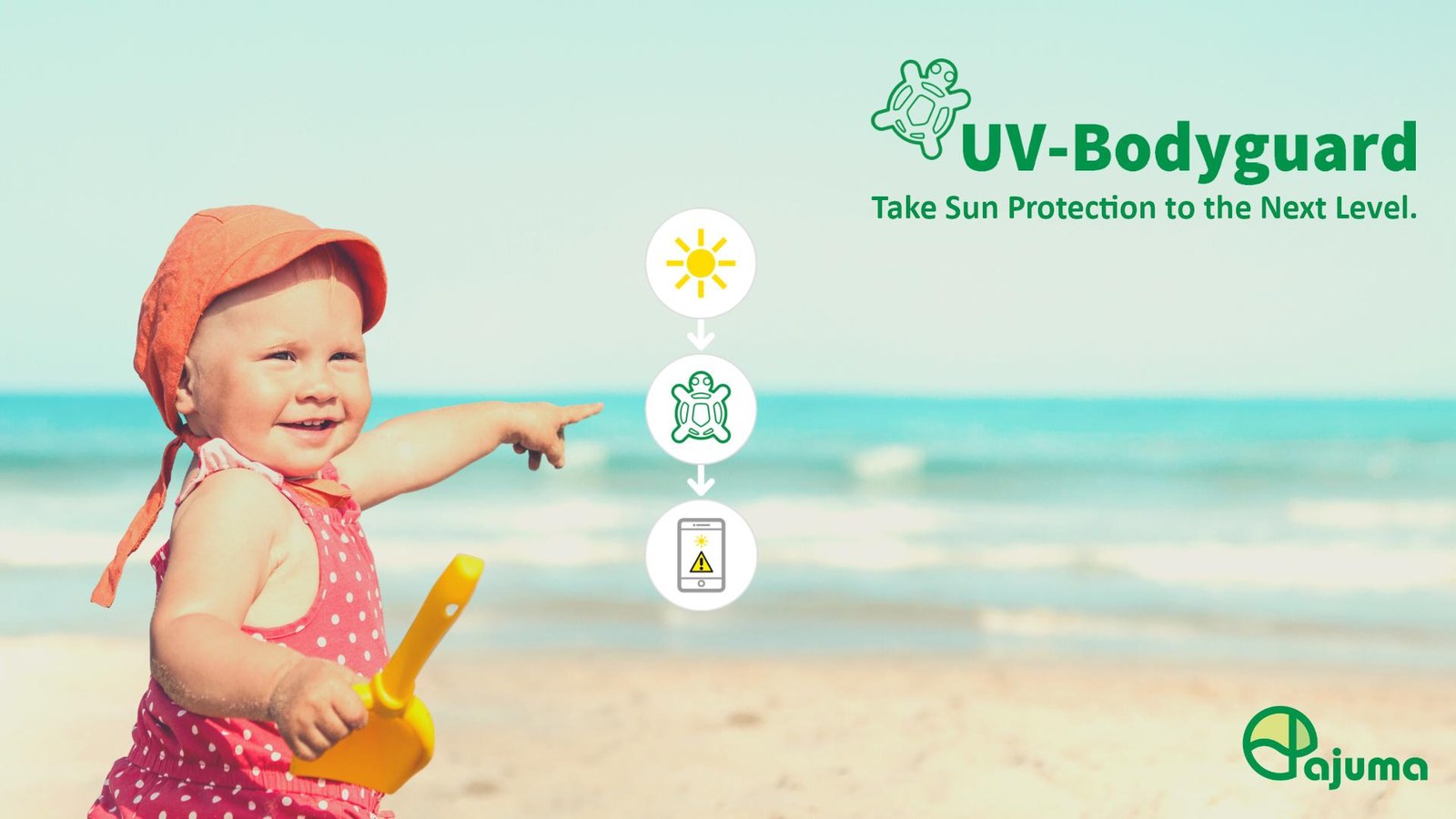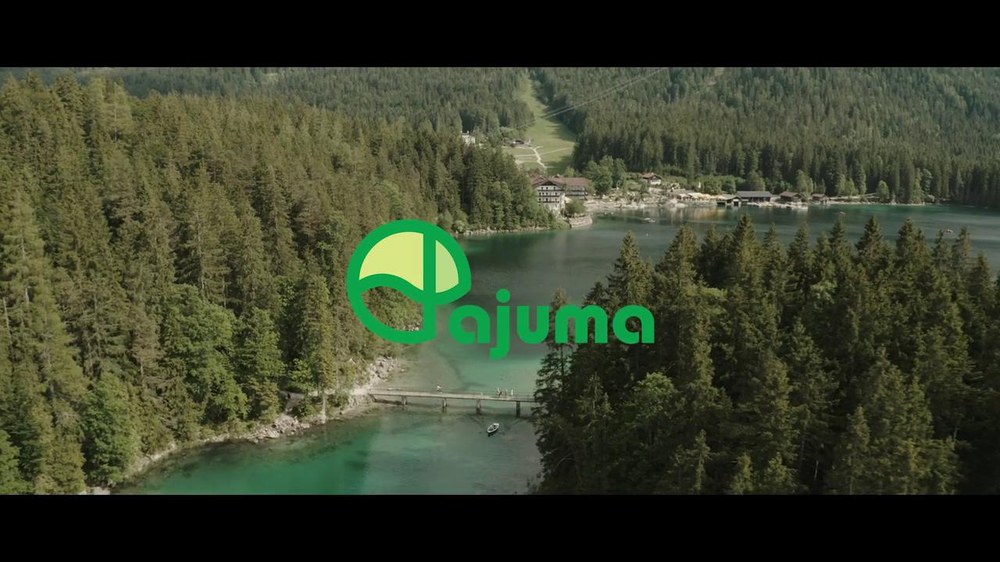UV-Bodyguard by ajuma – sophisticated technology to prevent sunburn

- The Copernicus Masters innovation competition recognises applications and ideas that use Copernicus data to address relevant business and societal challenges.
- DLR's special prize was awarded to UV-Bodyguard by ajuma. UV-Bodyguard is a small UV measurement assistant that helps users find the right amount of sunlight for themselves and their children, thereby preventing sunburn. Its motto? 'Enjoy the Sun carefree'.
- Focus: Space, health, Earth observation, digitalisation, Big Data
The Sun is important for life, but too much Sun exposure leads to sunburn and an increased risk of skin cancer. Annette Barth and Julian Meyer-Arnek have a young daughter who likes to play outside in the sunshine. This led the couple to start their own company, ajuma GmbH, and develop the UV-Bodyguard for her and all those who love the great outdoors, no matter their age. UV-Bodyguard is a wearable that is connected to an app on the user's smartphone and constantly measures levels of ultraviolet (UV) radiation. In this way, outdoor athletes and families can determine the most appropriate and healthy UV level for their skin type. In addition, they are informed about how much time they have left in the sunshine and are warned in time about the risk of sunburn – true to the motto 'Enjoy the Sun safely'.
This year, the German Aerospace Center (Deutsches Zentrum für Luft- und Raumfahrt; DLR) awarded first prize to UV-Bodyguard by ajuma as the best application idea in the 'Earth Observation' division of the Copernicus Masters competition. The DLR Award was presented to the two innovators at a ceremony held in Helsinki on 4 December 2019.
Gunter Schreier of the DLR Earth Observation Center (EOC) in Oberpfaffenhofen says: "DLR's Earth Observation Center makes a significant contribution towards ensuring that the data and products from the Sentinel-5P satellite are made available quickly. We are particularly pleased that ajuma is using the results of the Copernicus programme to facilitate personalised preventative healthcare." The EOC coordinates the competition on behalf of DLR.

The Sun is important for life: 'Enjoy the Sun safely'
Your consent to the storage of data ('cookies') is required for the playback of this video on Quickchannel.com. You can view and change your current data storage settings at any time under privacy.
©ajuma
Interview with the two innovators
Annette Barth (AB) and Julian Meyer-Arnek (JMA)
How did you decide to submit your idea to the Copernicus Masters ideas competition?
I first came across the Copernicus Masters competition in 2011. At that time, we were working at DLR, along with many other partners, on a European project addressing the theme of air qualit.
One special feature of UV-Bodyguard is the UV prediction function, which enables the user to sensibly plan a day in the Sun and avoid a 'UV overdose'. As we were also using data from the European Copernicus Earth observation programme, entering the competition was the obvious thing to do.
How did you come up with UV-Bodyguard?
I became involved with the 'UV-Check' project for the German Dermatologists Association almost at the exact time at which I started working at DLR, so I was always somewhat biased towards the whole UV topic.
Our daughter was born two-and-a-half years ago, so we have been thinking about UV and children quite a lot. Infants are very sensitive to sunlight – they can only stay in the midday summer Sun for about five to 10 minutes without the required protection, and even with protection factor 50, the acceptable amount of time spent in the Sun is used up quite quickly. Numerous factors affect the received UV intensity, such as the type of ground surface, amount of cloud cover, time of day, season and altitude. We wanted to act responsibly when it came to our daughter, and that included how we dealt with sunlight exposure. As there were no UV sensors of the kind that we were imagining, we made the decision to develop UV-Bodyguard ourselves.
How exactly does ajuma's UV-Bodyguard work?
UV-Bodyguard is a wearable containing special UV measurement technology. This wearable is connected to a smartphone via Bluetooth and continuously measures UV radiation intensity. In the corresponding smartphone app, the users enter their skin type and the protection factor of their Sun lotion. Users can see how much 'healthy' time in the Sun they have already used up, how long they can still stay in the Sun, and they will be warned before the onset of sunburn – in real time. The UV-Bodyguard app offers UV prediction for the users' location. The necessary information for this is taken from the portfolio of existing Copernicus data products.
What do you hope to achieve as a result of winning the Copernicus Masters competition?
First of all, we wanted to present our idea to experts and to hear their opinions. We were overwhelmed by the positive feedback we received. Our victory at the 'DLR Environment and Health Challenge' of the Copernicus Masters shows us that our efforts have been understood and have a sound scientific foundation.
Contact with other users of Copernicus data and decision-makers in the field of Earth observation is very important to us. The aim is to further develop our current product and to be able to offer innovative products related to Earth observation in the future.
We are very pleased to also have had the opportunity to tell so many members of the general public about our idea.
What's next? What are your future prospects?
We have just won a place in the ESA Business Incubation Programme (ESA BIC). The ESA funds are supporting our marketing and enabling us to develop our product further. We will launch UV-Bodyguard in spring 2020 with a specially designed casing for outdoor athletes and another, turtle-shaped version for children. Our primary focus is on technology that connects people and the environment. We already have some ideas, but cannot reveal anything yet. Exciting times indeed!
The competition
The Copernicus Masters competition is organised by the Anwendungszentrum GmbH Oberpfaffenhofen (AZO). Spin-offs from the aerospace industry receive two years of assistance in the Anwendungszentrum at the Oberpfaffenhofen Airport. A number of companies have already successfully positioned themselves in the market thanks to start-up assistance. The Copernicus Masters Earth Observation Competition has been run since 2011 by AZO on behalf of the European Space Agency (ESA), together with strong partners like DLR. The prizes are awarded annually to innovative and forward-looking ideas and business concepts that use Earth observation data for commercial purposes and societally relevant projects, with a view to improving Copernicus user uptake. With more than 900 ideas submitted from over 70 countries, the competition has become the leading international network for innovative Earth observation applications. The competition is primarily aimed at start-ups and small and medium-sized enterprises, as well as researchers and students.


